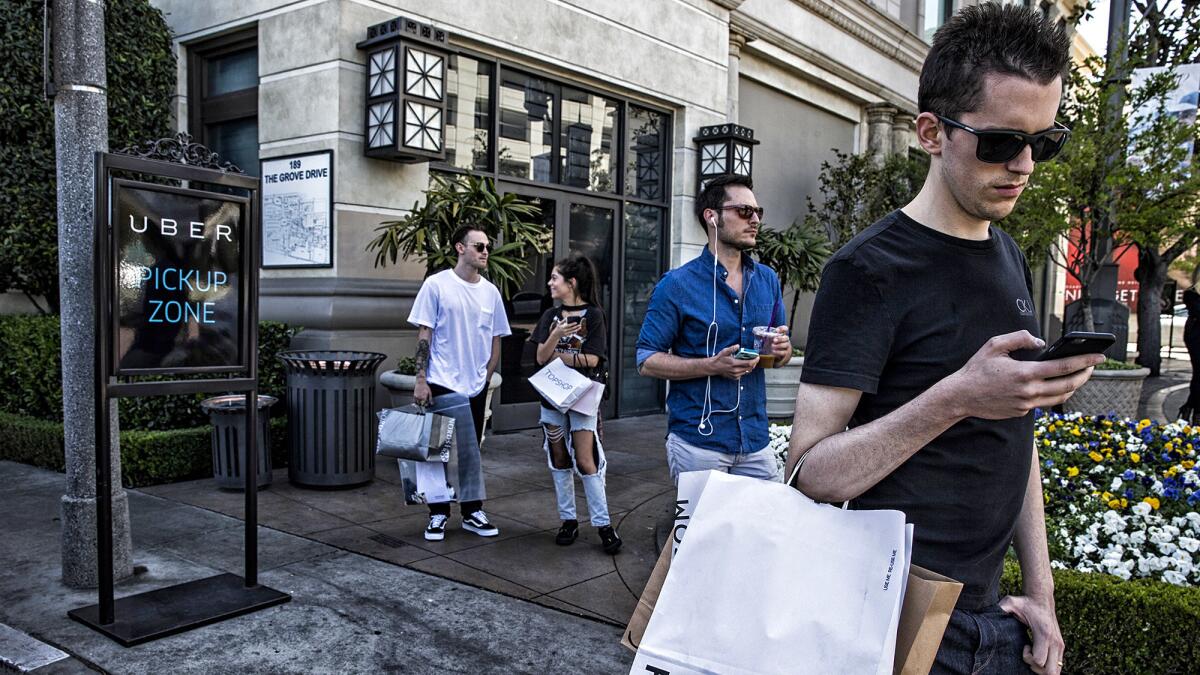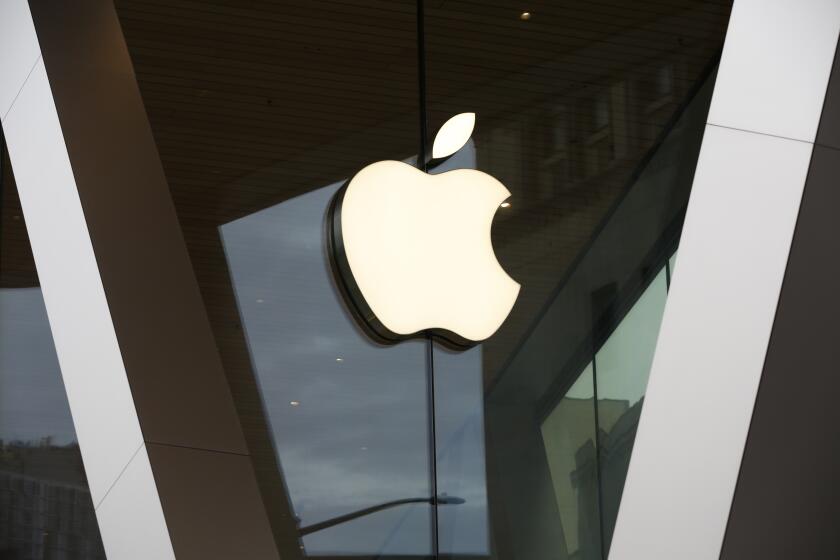When car ownership fades, this parking garage will be ready for its next life
- Share via
One of the country’s biggest apartment developers is working on plans for a grand residential complex in downtown Los Angeles that includes what appears to be an ordinary garage.
There will be row upon row of lined stalls at street level and two floors underground to store nearly 1,000 cars of tenants and visitors to the trendy Arts District, where parking is relentlessly hard to find.
But when it’s completed in about four years, the ample garage will be one of the first of its kind in Los Angeles: It’s designed to eventually serve other uses.
AvalonBay Communities Inc. has planned the garage for a time when ride-sharing services such as Uber and self-driving taxis whittle down car ownership until parking places become expendable.
That might mean its level rather than inclined floors common to many garages could someday be converted into shops, a gym and a theater.
“Our world is going to change radically and we are going to be alive to see it. It’s not a generation away, it’s 10 years away,” said Los Angeles architect Andy Cohen, who is not involved with the project but has created a presentation he gives to clients about the architectural implications of the transportation revolution.
AvalonBay is not the only real estate developer that has bought into the idea. Rick Caruso, the owner of the Grove and other upscale shopping centers, is working with Google to prepare for the arrival of self-driving cars and is looking forward to eventually swapping mall parking spaces for apartments, restaurants and stores.
The strategy reflects a consensus among some developers and planners that California’s vaunted car culture is inevitably going to run out of gas — as inconceivable as that might be for many adults who have spent decades controlling their own destiny behind the wheel.
Cohen, co-chief executive of architecture firm Gensler, predicts car ownership will peak around 2020 and then start to decline, with more Americans relying on some form of ride-sharing than their own vehicles by 2025.
That means cars gradually would disappear from home garages, curbs and parking structures, freeing up acre upon acre of real estate for new uses.
“One of the great changes in the next 20 years is going to be redevelopment of parking garages,” said Christopher Leinberger, chairman of the Center for Real estate & Urban Analysis at George Washington University.
There is a lot to work with: About 500 million parking spaces serve this nation of nearly 326 million people, according to Gensler. Parking infrastructure covers an estimated 3,590 square miles, an area larger than Delaware and Rhode Island combined.
The public is already fascinated with the race to perfect self-driving cars, which would free up garage space even if most Americans were to own one of the new high-tech vehicles.
A car could drop off a couple at the front door of their apartment building and then disappear into a garage untrammeled by wandering humans where vehicles delicately park themselves inches apart. The total amount of garage space needed to maneuver and park a car would be more than cut in half, Leinberger said
But he expects self-driving cars to become commodities, not possessions. People will summon them only when they need them, so the rate of car ownership should drop drastically, he predicts.
“Cars will be wandering the city 24-7, so you don’t need to own one,” Leinberger said. “You just rent it as you need it.”
How cities would look and function if far fewer people owned cars is impossible to say, however, so the best real estate developers can do now is start hedging their bets.
Residential landlord AvalonBay has been expanding the number of electric-car charging stations in apartment complexes it is building in West Hollywood and Hollywood and making prominent drop-off points for ride sharing.
But it has far more dramatic car-related ideas for the 475-unit apartment complex it is planning for downtown L.A.
The Virginia-based company, which operates nearly 84,000 apartments in 10 states, is beginning to plan for a future with fewer — and autonomous — cars.
“We’re just starting to do this as a company on a nationwide level,” said Mark Janda, senior vice president of development.
Preliminary concepts for the Arts District project set to start construction in 2019 presume that demand for parking will fall in years ahead.
Garage floors are typically slanted to eliminate the need for ramps, but AvalonBay will make these floors flat so that they can more easily be repurposed when parking demand dips.
Janda envisions portions of the two levels of underground parking being converted to a gym, a theater and perhaps other recreational uses when cars can park themselves two or three deep in tighter spaces.
The first floor could be reconfigured to plug in more shops and restaurants and enable smooth and constant pick-ups and drop-offs.
“We are designing it so in the future, if demand for parking decreases dramatically, we have the flexibility to go back to the city and ask for additional entitlements to change uses from parking to whatever,” Janda said.
Cohen, the L.A. architect, advised that garages on the drawing board also have higher-than-normal ceilings — up to 13 feet — to accommodate future uses such as offices. He also would place elevators and stairs in the middle the way they are in offices. And he would put what he calls knock-out panels in the ceiling and floors to create future light wells.
The exterior design cannot be an afterthought too, he said. If the garage is above ground with offices above, it has to look like the rest of the building so windows can be added after the conversion.
But don’t expect that developers today will start constructing projects without a garage, Janda said.
“People in California still rely on their cars and expect to be able to park them,” he said.
For that matter, despite what some believe is the inevitability of a transportation revolution, many builders are reluctant to pay for flexibility until changes in driving habits are more pronounced, said Los Angeles real estate attorney Justin Thompson of Nixon Peabody.
A lot of developers may think, “Well, that’s going to be on the back burner for a while,” Thompson said, “but the progressive developers are going to factor this in.”

Shopping center magnate Caruso counts himself among the more progressive. He said he is committed to spending millions of dollars preparing for autonomous cars, and he’s already working with a division of Google called Intersection to improve the arrival and departure experience at his high-end developments.
Intersection is developing technology that integrates beams, sensors, license-plate recognition and phone apps that can radically improve the experience, he said.
When the concierge knows you are about to arrive, he might mix a cup of coffee the way you like it to hand to you as you alight. The goal, Caruso said, is to make coming and going to the shopping center as frictionless as possible.
He’s already experienced the changes wrought by Silicon Valley.
The Grove, in L.A.’s Fairfax district, is one of the city’s busiest Uber destinations, Caruso said, with thousands of people arriving and departing every day at the mall’s designated ride-sharing point.
This popularity of ride sharing has convinced him that more big changes in driving habits are coming as autonomous cars gain a share of the auto market.
He expects that between ride sharing and autonomous cars he might have to start converting his parking garages to other uses as soon as 2025 or 2030.
Surface parking lots at his suburban malls such as the Promenade at Westlake and the Commons at Calabasas could turn from asphalt into verdant mixed-use complexes with apartments, offices and more stores and restaurants.
The big garages at the Grove and Americana at Brand in Glendale could see the addition of grocery stores and other retail outlets on the ground floors.
“As you go above that, it gets more complicated,” he acknowledged. The towering garages “may become obsolete and have to come down and be replaced.”
While the prospect of dramatic changes in the way people get around stirs the blood of developers like Caruso, the anticipated years-long transition period to widespread autonomous vehicle use holds some dread for the general manager of the Los Angeles Department of Transportation, Seleta Reynolds.
“I think it’s going be very chaotic,” she said.
This isn’t a fleeting moment, some interesting blip that will come and go. This will change traffic in L.A. in a very positive way.
— Rick Caruso, owner of the Grove
Falling parking fees and fines could take a big bite out of public budgets and landlords’ income, Reynolds said. And the time period when “a vehicle drives itself until a human intervenes is probably going to be the worst, but that is a place we are going to have to muddle through.”
Other challenges and technical improvements loom to be worked out, Reynolds said. If cars know where they are going, do streets still need curbs? Perhaps some streets could be electronically “closed” after rush hour and used for recreation.
“We should be focusing on strong neighborhoods and social cohesion,” Reynolds said. “That’s the promise of autonomy if we’re really able to get it right.”
Caruso dismisses skeptics who say Angelenos will never quit driving their own vehicles — and that ride sharing and autonomous cars are just a passing fancy.
“This isn’t a fleeting moment, some interesting blip that will come and go,” he said. “This will change traffic in L.A. in a very positive way.”
To read the article in Spanish, click here
Twitter: @rogervincent
ALSO
Apple receives permit to test self-driving cars in California
Doing auto repairs at an HOA parking lot? Here’s a crash course in the violations
Robert W. Taylor, visionary figure in the birth of personal computing and the Internet, dies at 85
More to Read
Inside the business of entertainment
The Wide Shot brings you news, analysis and insights on everything from streaming wars to production — and what it all means for the future.
You may occasionally receive promotional content from the Los Angeles Times.











